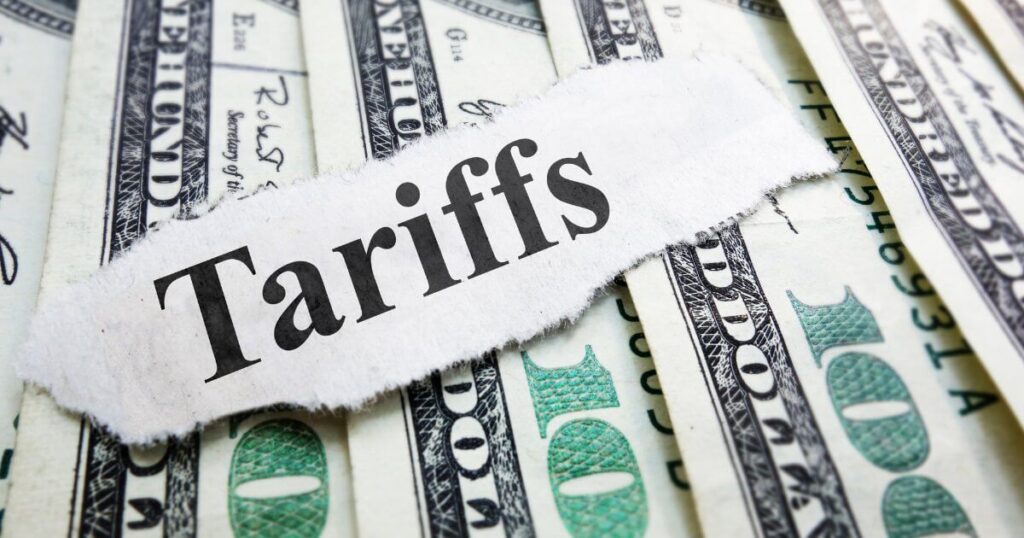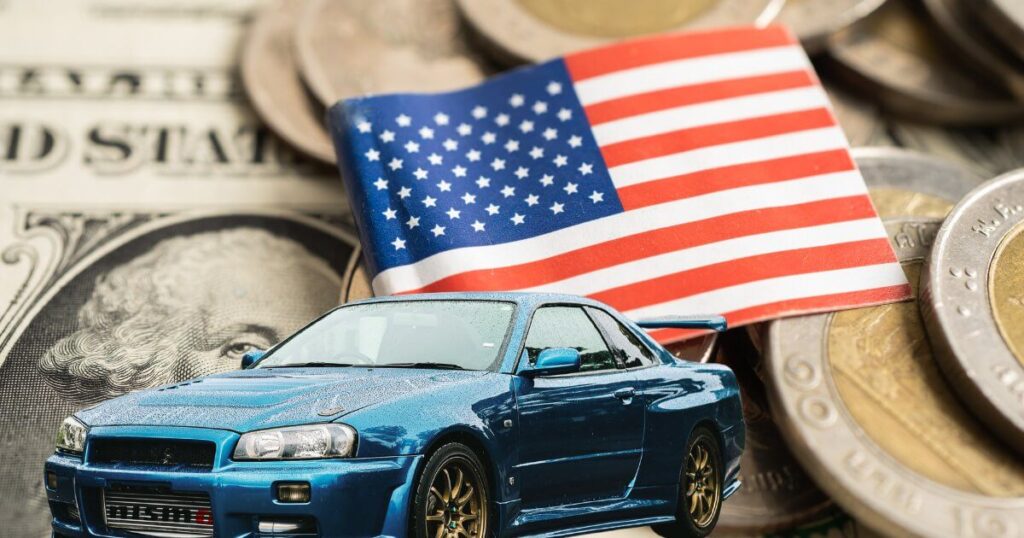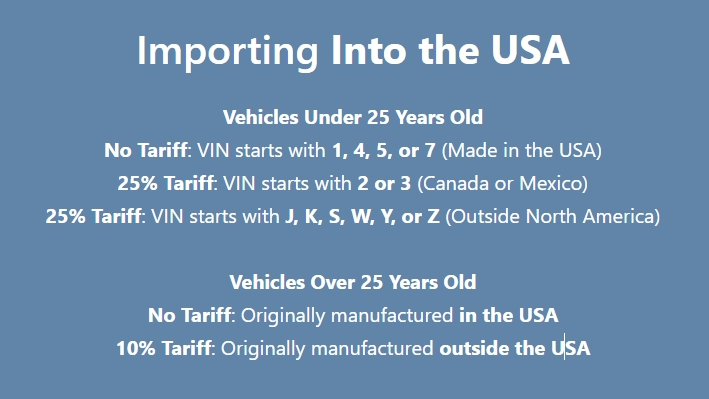Thinking of bringing a vehicle into the U.S. from Canada or overseas? Maybe you’re relocating for work, buying a car you can’t find stateside, or bringing back a favorite ride from your travels. Sounds exciting—until you realize importing a car isn’t just about logistics. It’s also about tariffs. And depending on your car’s origin and age, the tariff could be zero—or a whopping 25%.
As a trusted name in cross-border shipping, US Canada Auto Transport is here to make sure you’re well-prepared. Here’s the latest information you need for 2025, explained in a clear, easy-to-digest format, with focus on imports into the United States.
Vehicle Import Tariffs: What You Need to Know?

Tariffs are government-imposed fees applied to goods entering a country. When it comes to cars, these fees can quickly add thousands of dollars to your import cost. Knowing your vehicle’s tariff classification in advance allows you to plan better—and avoid surprises at the border.
Two key factors determine the tariff rate:
- Where the vehicle was manufactured
- Whether the vehicle is older or younger than 25 years
Let’s take a closer look at each of these.
Importing Vehicles Under 25 Years Old
Cars under 25 years old are subject to stricter rules, especially regarding emissions and safety standards. But tariffs? That’s a different beast. Your Vehicle Identification Number (VIN) tells you everything you need to know about the origin—and potential duty costs—of your car.
No Tariff: VIN starts with 1, 4, 5, or 7 (Made in the USA)
If your vehicle was made in the United States, you’re in luck. These vehicles typically enter duty-free—even if they’ve spent a few years in Canada. You can identify a U.S.-made car by its VIN starting with 1, 4, 5, or 7.
Let’s say you’re importing a 2019 Jeep Grand Cherokee from Alberta. Check the VIN. If it starts with “1,” it means the car was assembled in the U.S., and you won’t owe any import tariff. You’ll still need to deal with paperwork and EPA/DOT compliance, but tariff-wise, you’re in the clear.
25% Tariff: VIN starts with 2 or 3 (Canada or Mexico)
Even though Canada and Mexico are part of the USMCA trade agreement, vehicles manufactured there still face a 25% tariff when imported into the United States—unless specific exemptions apply (e.g., U.S. citizens moving back home with their own vehicle).
If the VIN starts with “2” (Canada) or “3” (Mexico), expect to pay. This surprises a lot of people who assume that free trade equals free movement. Unfortunately, tariff policy isn’t that simple.
25% Tariff: VIN starts with J, K, S, W, Y, or Z (Outside North America)

Imported a luxury car from Germany? Picked up a Japanese sports car during your time abroad? If the vehicle is under 25 years old and the VIN starts with any of the following—J (Japan), K (South Korea), S (UK), W (Germany), Y (Sweden), or Z (Italy)—you’re looking at a 25% tariff.
That fee applies even if the vehicle meets all other U.S. requirements. A lot of people run into this when buying from international dealerships or auctions.
Quick tip: Always ask for the VIN before you finalize an overseas purchase. A small detail like the first digit can change your total cost by thousands of dollars.
Quick Reference Table: Tariffs for Vehicles Under 25 Years Old
| VIN Starts With | Manufacturing Location | Tariff Rate |
| 1, 4, 5, 7 | United States | 0% |
| 2, 3 | Canada or Mexico | 25% |
| J, K, S, W, Y, Z | Outside North America | 25% |
Importing Vehicles Over 25 Years Old
If your car is over 25 years old, the game changes. That’s because the 25-year mark exempts a vehicle from many EPA and DOT regulations, making it easier to import and register. Tariffs, however, still apply—just at different rates.
No Tariff: Made in the USA (25+ Years Old)
Did you find a vintage Ford Bronco in Ontario? If it was built in the U.S. more than 25 years ago, you won’t owe a dime in tariffs. As long as you can prove its origin—usually through the VIN and manufacturing documents—there’s no import duty.
This is a major advantage for collectors or returning U.S. citizens who’ve held on to a U.S.-made vehicle overseas.
10% Tariff: Made Outside the USA (25+ Years Old)
If the car was manufactured abroad—even if it’s a classic—you’ll likely pay a 10% tariff when importing it into the U.S. This is a break from the 25% tariff on newer foreign-made vehicles, and one reason many car enthusiasts import older Japanese or European models.
For example, importing a 1990 BMW from Germany would only result in a 10% duty. That’s a far better deal than trying to import a 2015 model, which would incur a 25% charge.
Quick Reference Table: Tariffs for Vehicles Over 25 Years Old
| Vehicle Origin | Tariff Rate |
| United States | 0% |
| Outside the USA | 10% |
How to Tell Where Your Vehicle Was Made
Here’s a helpful breakdown of VIN prefixes and what they mean:
| VIN Starts With | Country |
| 1, 4, 5, 7 | United States |
| 2 | Canada |
| 3 | Mexico |
| J | Japan |
| K | South Korea |
| S | United Kingdom |
| W | Germany |
| Y | Sweden |
| Z | Italy |
Use this as your first checkpoint before you ship anything across the border.
Plan Before You Import
Importing a vehicle into the United States isn’t just about getting it from point A to B—it’s about knowing what’s waiting for you at the border. Tariffs can quickly turn a “great deal” into a financial burden if you’re not prepared.
To sum it up:
- Check the VIN first — It tells you where the vehicle was made.
- Know the 25-year rule — It impacts both emissions rules and tariff rates.
- Calculate your costs — Include tariffs, customs fees, and compliance work in your total budget.
At US Canada Auto Transport, we help customers navigate these exact issues every day. If you need help figuring out your vehicle’s tariff classification—or just want a smooth, hassle-free import process—we’re here for you.
Need Help with Your Import?
Don’t let tariffs or border regulations slow you down. Whether you’re moving, buying, or collecting, our experts at US Canada Auto Transport are ready to guide you every step of the way.
Contact Us for a Free Quote. Let us handle the logistics while you enjoy the ride.


